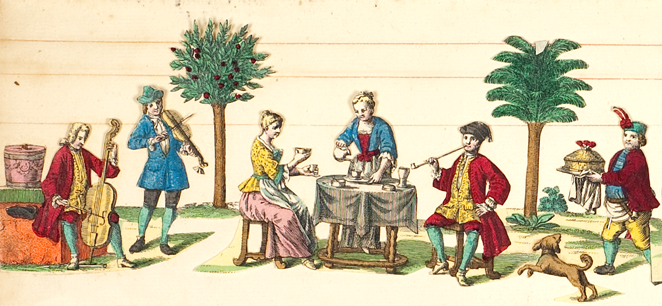Collection context
Summary
- Creator:
- Bingham, William
- Abstract:
- The Bingham, W. mss., 1752-1891, consist of the correspondence, writings, personal and business papers of American statesman William Bingham, 1752-1804.
- Extent:
- 9 Linear Feet (5 boxes, 1 oversize)
- Language:
- English , French .
- Preferred citation:
[Item], Bingham, W. mss., Lilly Library, Indiana University, Bloomington, Indiana.
Background
- Biographical / Historical:
William Bingham was born on April 8, 1752, in Philadelphia, Pennsylvania, to William Bingham and Mary "Molly" Stamper. In 1768, he graduate from the College of Philadelphia and trained as a merchant under Thomas Wharton. From 1770-1776, Bingham served as the British consul in St. Pierre, Martinique. Soon after his consulship ended, he agreed to remain in the West Indies and serve as an agent of the Continental Congress by overseeing commercial privateering and espionage in support of the American Revolution. In 1780, Bingham returned to Philadelphia and married the daugher of his business partner, Anne Willing. He owned a fleet of ships and large tracts of land in Maine, New York and Pennsylvania, and over time, he became the wealthiest man in the United States. Bingham was one of the founders of the Bank of Pennsylvania, chartered on December 31, 1781 as the Bank of North America, the first bank in the United States.
Bingham's political career included positions as a Continental Congress member (1786-1788), Pennsylvania state representative (1790-1791) and senator (1794-1795), and a United States senator (1795-1801). George Washington, Benjamin Franklin, Alexander Hamilton, and the Earl of Shelburne William Petty were counted among his friends both politically and socially. They, along with business acquaintances, foreign visitors, relatives and friends, were frequent guests at the Bingham mansion in Philadelphia, where Bingham and his much-admired wife were among the social elites of the nation's first capital. Bingham's daughter, Anne Louisa Bingham, married Alexander Barring, later first Baron Ashburton, 1774-1848, who joined Daniel Webster in resolving the boundary line of northeast Maine between the United States and Canada. The Webster-Ashburton Treaty of 1842 also provided for the suppression of slave trade off the African coast.
In 1801, Bingham retired from public life and moved to Bath, England, where he died on February 7, 1804, at the age of 51. Bingham's life and career are described in The Golden Voyage (1969) by Robert C. Alberts. His land interests are detailed in William Bingham's Maine Lands (1954) by Frederick S. Allis.
- Scope and Content:
General correspondence is arranged chronologically from 1757-1891. Correspondence of interest includes a letter Thomas Jefferson wrote from Paris to Anne (Willing) Bingham, Feb. 7, 1787; a letter from George Washington to William Bingham enclosing the plan for his barn, Dec. 8, 1792; and the letter from Lord Lansdowne (Earl Shelburne) to Mrs. Bingham concerning the Gilbert Stuart full-length portrait of George Washington, Nov. 1796.
Business papers include those of the Bank of the United States, 1791-1801, and Bingham's shipping interests, especially regarding the Canton and the America. Estate consists of accounts related to Bingham's estates from 1813 to 1846. Family includes the papers of family members Alexander Barring, William Bingham Barring, and William Bingham, Jr. Personal papers and writings relate to Bingham's political opinions, notes, and memoranda. Prizes discusses ships taken by privateers; of interest are papers documenting the controversy over the legality of the seizure of the Hope. Property includes accounts, deeds, maps, and settlement instructions for Bingham's substantial ownership of land in Maine, New York and Pennsylvania .
The Webster-Ashburton Treaty papers include correspondence, dispatches of Daniel Webster, and materials discussing the slave trade. Miscellaneous includes other legal documents and French government claims (chiefly in French).
For digitized content, see Digital Collections.
- Acquisition information:
- Purchase: 1997
- Arrangement:
The collection is organized into the following series: I. General correspondence; II. Business; III. Estate; IV. Family; V. Personal papers and writings; VI. Prizes; VII. Property; VIII. Webster-Ashburton Treaty; IX. Miscellaneous.
- Physical location:
- Lilly - Stacks
Indexed Terms
- Subjects:
- Public lands --Maine.
Privateering
Shipping. - Names:
- United States. Congress. House
United States. Congress --Constituent communication.
United States. Congress --Ethics.
United States. Congress --Powers and duties.
United States. Congress --Reform.
Democratic Party (U.S.).
United States. Army. Corps of Engineers --Civil functions.
Marble Hill Nuclear Power Plant (ind.).
Indiana Army Ammunition Plant (U.S.).
United States. Congress. House. Committee on Administrative Review.
United States. Congress. House. Committee on Foreign Affairs.
United States. Congress. House. Committee on International Relations.
United States. Congress. House. Committee on Post Office and Civil Service.
United States. Congress. House. Committee on Science, Space, and Technology.
United States. Congress. House. Committee on Standards of Official Conduct.
United States. Congress. House. Joint Committee on the Organization of Congress.
United States. Congress. House. Joint Economic Committee.
Bank of the United States (1791-1811)
Great Britain. Treaties, etc. United States, 1842 Aug. 9
Bingham, William, 1752-1804 --Correspondence.
Cobb, David, 1748-1830.
Webster, Daniel, 1782-1852.
Lansdowne, William Petty, Marquis of, 1737-1805.
Washington, George, 1732-1799.
Jefferson, Thomas, 1743-1826.
Online content
Access
- RESTRICTIONS:
-
This collection is open for research.
Many collections are housed offsite; retrieval requires advance notice. Please make an appointment a minimum of one week in advance of your visit.
- TERMS OF ACCESS:
-
Photography and digitization may be restricted for some collections. Copyright restrictions may apply. Before publishing, researchers are responsible for securing permission from all applicable rights holders, then filling out the Permission to Publish form.
- PREFERRED CITATION:
-
[Item], Bingham, W. mss., Lilly Library, Indiana University, Bloomington, Indiana.
- CAMPUS:
- Indiana University Bloomington
- LOCATION OF THIS COLLECTION:
-
1200 East Seventh StreetBloomington, Indiana 47405-5500, USA
- CAMPUS:
- Indiana University Bloomington
- CONTACT:
-
(812) 855-2452liblilly@indiana.edu

